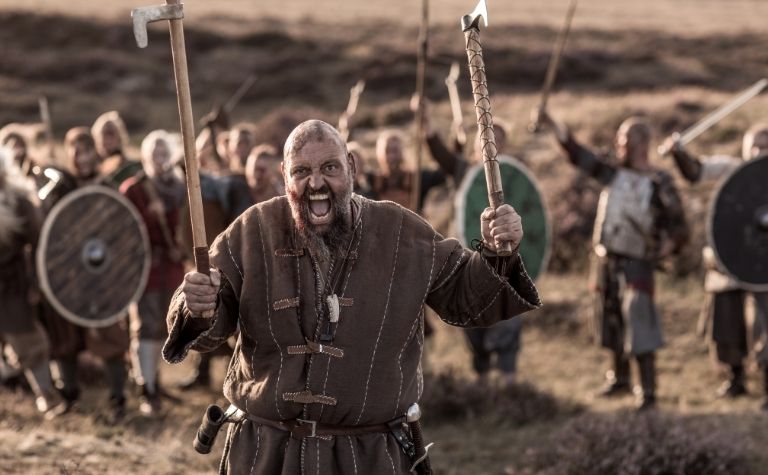In the 9th and 10th centuries A.D., Norse pirates known as Vikings launched a series of daring raids across Europe that cemented their reputation as some of the fiercest warriors in history.
Eventually, they took over large parts of present-day England and France and changed the course of history. But did they invade Paris?
The Vikings invaded Paris several times in the 9th century A.D. However, they did not permanently occupy the city on these occasions.
Instead, they returned to their Scandinavian homelands with the wealth they had plundered or were paid as ransom to cease their raids.
The remainder of this article will outline the history of the Viking raids on Paris and explain the part that the Vikings played in this tumultuous period of European history.
Also see Did Female Vikings Go On Raids? to learn more.

When Did the Vikings Raid Paris?
The Vikings first raided Paris in 845 A.D. Spurred on by the success of their first attack, they made three more raids on the city in the 860s before returning for a final time in 885 A.D.
On this last occasion, the Vikings laid siege to Paris for almost a year.
The Viking raids on Paris began in the aftermath of the death of Charlemagne–also known as Charles the Great–King of the Franks in 814 A.D. [1]
Charlemagne had united much of Western Europe through brutal military campaigns of expansion.
Declared the Holy Roman Emperor towards the end of his life, he had served as a bulwark against invading armies by doing most of the invading himself for much of this time.
The Vikings began their first forays into Frankish territory in 820 A.D. with a series of assaults that lasted two decades.
These raids were not entirely successful for the Vikings, but they helped them gain a foothold in Francia when Charlemagne’s successor Louis the Pious bought peace from them with land grants.
Emboldened by their initial success, the Vikings launched their first raid on Paris in 845 A.D.
By then, the Frankish kingdom had been divided among Louis’ three sons, and its armies further weakened.
On this occasion, a Viking raiding party led by Reginherus overpowered the army of Charles the Bald, King of West Francia, in just two days.
After sacrificing 111 of their opponents to Odin, the Viking party sailed down the Seine and reached Paris on Easter Sunday.
After pillaging the city and collecting a ransom from Charles, they made their way home laden with looted treasure.
This trip, too, was not an unabashed success. Much of the city’s wealth had been moved to safety in expectation of the Vikings’ arrival, and many of their men died of dysentery.
However, it showed enough promise for the Vikings to launch more raids in the succeeding decades.
These raids established a pattern of behavior in which Viking armies would repeatedly assault Frankish territories.
In response, beleaguered Frankish kings would buy peace with grants of land or gold and silver.
The Frankish kings’ appeasement of the Viking parties only encouraged follow-up raids with more ransom demands.
In 885 A.D., a large Viking fleet led by Sigfried arrived at Paris once more.
By then, the Franks had built several bridges across the Seine to deter the Viking raiding parties.
And these bridges had also been fortified with towers. The city was also led by Odo, Count of Paris, a more resolute commander than the Frankish king.
Although the Vikings favored short, quick raids, they were drawn into pursuing a yearlong siege of the city when Odo turned down their demand for ransom.
After a long bout of plague, the Frankish king Charles the Fat finally acceded to the Vikings’ demands.
However, this turned out to be the last of the Vikings’ assaults on Paris.
In 911 A.D., Charles the Simple worked out a lasting peace with a Viking leader named Rollo through the Treaty of Saint Clair sur Epte.
As a result, Rollo converted to Christianity, married the king’s daughter, and established the kingdom of Normandy, the land of the Norse in Francia.
Also see Did the Vikings Discover America? to learn more.

Did the Vikings Succeed in France?
The Vikings did succeed in looting and plundering territories in present-day France on several occasions.
They also established a kingdom of Norsemen in these territories.
However, the Vikings failed to take over the entire kingdom of Francia at any point in time.
On multiple occasions between 820 and 911 A.D., Viking raiding parties assaulted towns, cities, and the countryside of areas within the kingdom of Francia.
On many of these raids, the Vikings looted and plundered Frankish subjects and obtained extravagant ransoms from Frankish rulers in exchange for peace.
They also built up their own settlements on Frankish territory on lands obtained as part of the peace offerings.
Eventually, the Viking leader Rollo established the kingdom of Normandy, a land for the Norse people in Francia.
However, the Vikings never succeeded in taking over the entire kingdom of Francia.
Partly, this was by design, as the Vikings preferred a strategy of short, quick raids that were more lucrative and resulted in less loss of lives.
In spite of this, the Viking raids did lead to significant loss of lives, even if not always in war.
Also see Are Scottish People Descendants of Vikings? to learn more.

When Did the Vikings Leave Paris and Why?
The Vikings finally left Paris for good in 886 A.D. when Charles the Fat, King of the Franks, paid them a ransom to leave after a yearlong Viking siege of Paris.
Later, his successor Charles the Simple, made a settlement with a Viking leader named Rollo, buying a lasting peace.
Like many of the earlier Viking raids, the siege of 885 A.D. ended when a Frankish king paid a ransom to a party of raiding Vikings.
On this occasion, Charles the Fat paid the Viking leader Sigfried in gold and silver.
However, the paying of a ransom would have encouraged future raiding parties and not deterred them.
If the Vikings stopped raiding Paris, it was likely because they settled on Frankish territory and established their own kingdom as per the terms of the Treaty of Saint Clair sur Epte that Charles the simple signed with the Viking leader Rollo.
As per the terms of the treaty, Rollo married the king’s daughter, converted to Christianity, and established his own kingdom on Frankish soil.
This was the kingdom of Normandy, the land of the Norse. Ultimately, the Franks bought peace with the Vikings by partnering with them.
Conclusion
Between 845 and 885 A.D., the Vikings invaded Paris several times, successfully plundering wealth or collecting ransom on each occasion.
Also see What Color of Eyes Did Vikings Have? to learn more.
References:
[1] Source
